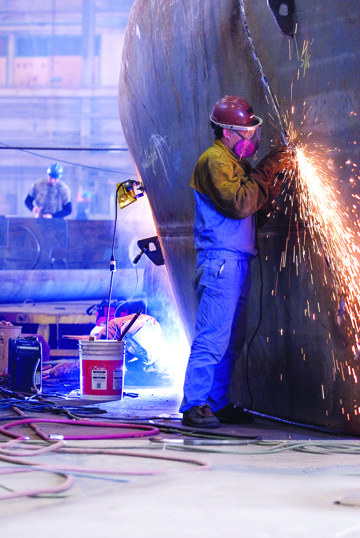
A few years ago the words “manufacturing” and “growth” were rarely encountered in the same sentence, especially in Rhode Island.
Now, at least according to the Governor’s Workforce Board, manufacturing is taking a place alongside bioscience, construction, defense, health care, hospitality, information technology and the marine trades as potential growth sectors deserving of their own industry-state, job-training partnership.
To form this partnership, the Workforce Board is seeking an “intermediary” from the manufacturing community to help align job-training policies and programs in a way that makes sure Ocean State manufacturers have a labor pool with the skills they need to grow.
“Anecdotally, but on a very frequent basis, we hear from manufacturers that they are having challenges filling the vacancies they have,” said Workforce Board Executive Director Rick Brooks. “We didn’t usually hear skills mismatches in manufacturing like we did in IT and health care. But we have increasingly heard they have jobs they can’t fill and that young workers are not being counseled by high schools [to] consider manufacturing.”
To set up this partnership with the manufacturing industry, the Workforce Board has $100,000 in state funding available to an organization or industry consortium with the best plans for providing educators and government officials a connection to the needs on shop floors. The partner could be an existing organization or a group formed specifically for the purpose.
As for why the communication and information-gathering function couldn’t be fulfilled by existing state resources, Brooks said the idea is to get as close to the private-sector job producers as possible.
“We don’t rule out any partner, but our goal is to have real-time information from Rhode Island manufacturers about their workforce needs,” Brooks said. “The most important aspect of any candidate is that they can effectively represent the industry.”
One of the first things the new manufacturing partner will be asked to do is produce a detailed study on the existing skills gap between employers and the Rhode Island workforce.
“They should look at the job vacancies and compare them to applicants to identify those skills that are not easy to find, so the education and training system can recruit and train for those skills,” Brooks said.
In the other seven industries with workforce partnerships, trade associations have been the most frequent intermediaries.
With that in mind, the Rhode Island Manufacturers Association would seem to be an obvious candidate to serve as an industry partner and Executive Director Bill McCourt said his organization is certainly interested.
“In our humble opinion, who better than us to lead that charge,” McCourt said. “But at the end of the day, we have such a vested interest in this that, should it not be us, then we would certainly support it in any way, directly or indirectly.”
McCourt said the skills gap the Workforce Board has identified is definitely real and Rhode Island manufacturers are struggling to find qualified workers for many job openings.
“We have a problem in that we have some companies looking for people and certainly a lot of people who need jobs, but can’t bring the two together,” McCourt said. “The skills that are needed are a step above a high school diploma, but not necessarily a bachelor’s.”
Examples of the skills manufacturers are looking for include the ability to read a blueprint, a solid foundation in mathematics and a facility for working with advanced technology, McCourt said. In general, about 80 percent of the skills a good job applicant needs can be taught outside the workplace with 20 percent job-specific and only acquired through an apprenticeship, internship or other on-the-job training.
As for what role manufacturing plays in the Rhode Island workforce, Brooks said despite the declines in the 20th century and the recession, manufacturing is still the fourth-largest employer in the state, with approximately 40,000 workers.
In addition, the manufacturing workforce is generally older than the state population as a whole, which would indicate that in the near future there will be significant job openings for younger workers.
“There is an expectation that there could be an uptick in manufacturing openings in the future and we want to be ready for it,” Brooks said. •












